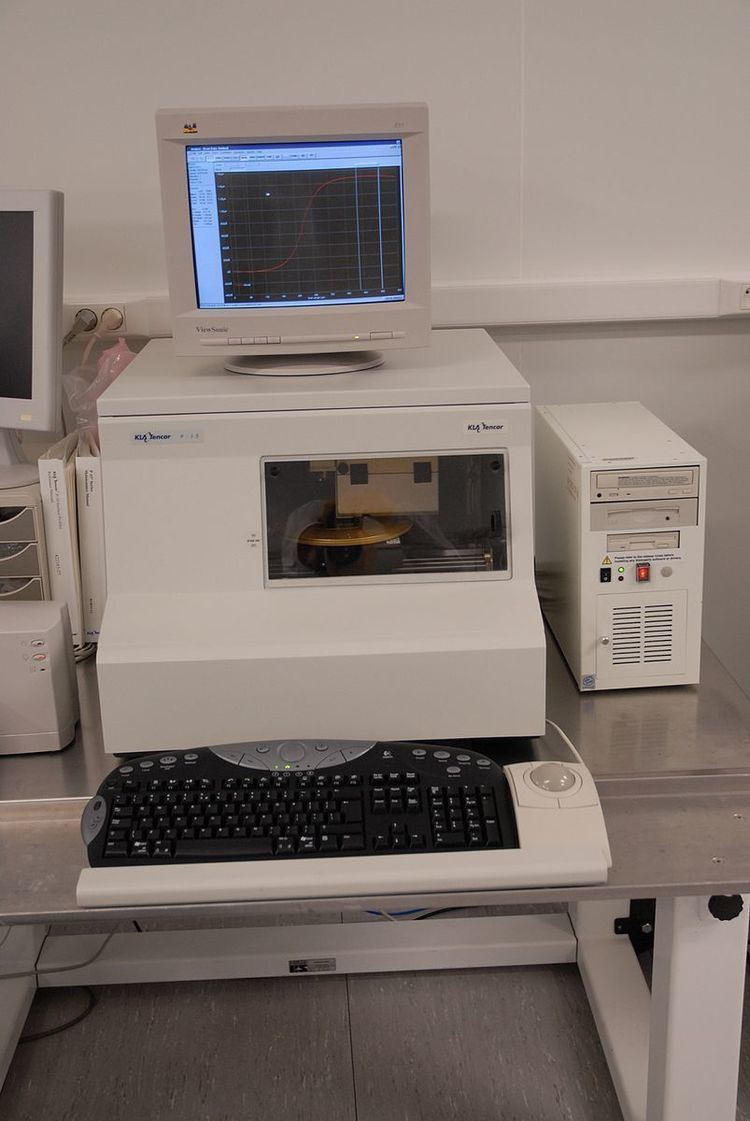 | ||
Profilometer is a measuring instrument used to measure a surface's profile, in order to quantify its roughness. Critical dimensions as step, curvature, flatness are computed from the surface topography.
Contents
- Types
- Contact profilometers
- Non contact profilometers
- Time resolved profilometers
- Fiber based optical profilometers
- References
While the historical notion of a profilometer was a device similar to a phonograph that measures a surface as the surface is moved relative to the contact profilometer's stylus, this notion is changing with the emergence of numerous non-contact profilometery techniques.
Non-scanning technologies measure the surface topography within a single camera acquisition, XYZ scanning are no longer needed. As a consequence dynamic changes of topography are measured in-real time. Nowadays profilometer are not only measuring static topography but also dynamic topography such systems are described as time-resolved profilometers.
Types
Contact profilometers
A diamond stylus is moved vertically in contact with a sample and then moved laterally across the sample for a specified distance and specified contact force. A profilometer can measure small surface variations in vertical stylus displacement as a function of position. A typical profilometer can measure small vertical features ranging in height from 10 nanometres to 1 millimetre. The height position of the diamond stylus generates an analog signal which is converted into a digital signal, stored, analyzed, and displayed. The radius of diamond stylus ranges from 20 nanometres to 50 μm, and the horizontal resolution is controlled by the scan speed and data signal sampling rate. The stylus tracking force can range from less than 1 to 50 milligrams.
Advantages of contact profilometers:
Non-contact profilometers
An optical profilometer is a non-contact method for providing much of the same information as a stylus based profilometer. There are many different techniques which are currently being employed, such as laser triangulation (triangulation sensor), confocal microscopy (used for profiling of very small objects), low coherence interferometry and digital holography.
Advantages of optical profilometers
Time-resolved profilometers
Non-scanning technologies as digital holographic microscopy enable 3D topography measurement in real-time. 3D topography is measured from a single camera acquisition as a consequence the acquisition rate is only limited by the camera acquisition rate, some systems measure topography at a frame rate of 1000 fps. Time-resolved systems enable measurement of topography changes as healing of smart materials or measurement of moving specimens. Time-resolved profilometers can be combined with a stroboscopic unit to measure MEMS vibrations in the MHz range. The stroboscopic unit provides excitation signal to the MEMS and provides trigger signal to light source and camera.
Advantage of time-resolved profilometers
Fiber-based optical profilometers
Fiber-based optical profilometers scan surfaces with optical probes which send light interference signals back to the profilometer detector via an optical fiber. Fiber-based probes can be physically located hundreds of meters away from the detector enclosure, without signal degradation. Here are the additional advantages of using fiber-based optical profilometers:
